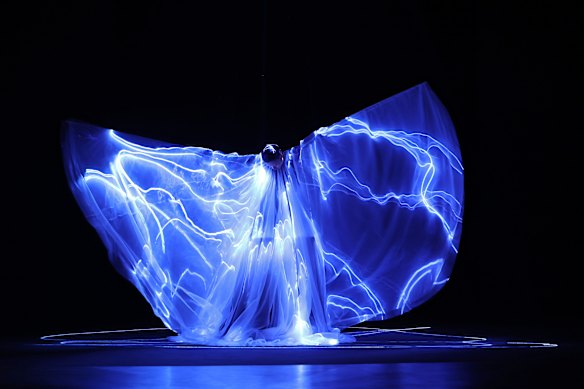
Iris van Herpen made a striking statement in the fashion world with her latest haute couture collection presented in Paris. The centerpiece of the show was an extraordinary dress made from living algae, marking a bold departure from traditional couture. This innovative creation is a testament to the designer’s vision of merging art with biology, showcasing a future where fashion collaborates with nature.
The dress features 125 million bioluminescent algae known as Pyrocystis lunula. These microorganisms glow in response to movement, similar to luminescent plankton illuminating ocean waters. Worn by a model, the ensemble comprised a dress and leggings, presenting an ethereal aesthetic reminiscent of an otherworldly crustacean. The unique garment, with its aquatic hues and jelly-like texture, emitted a soft blue glow rather than bright beams, creating a captivating visual effect.
In her own words, van Herpen described the experience of wearing the dress as “visceral.” She noted that, contrary to potential concerns, the ensemble did not produce any unpleasant odors. This piece was more of an experimental exploration rather than a commercially available item. According to van Herpen, the approach signifies “the next step in not being inspired by nature, but collaborating with nature,” moving beyond simple floral patterns to a more profound biological symbiosis.
Collaboration with Biodesigner Chris Bellamy
The creation of this living dress involved a partnership with biodesigner Chris Bellamy, who collaborated with van Herpen on the project for approximately five months. The algae were cultivated in seawater, nurtured in controlled conditions, and ultimately housed in a protective membrane that formed the dress. This membrane functions as a self-contained environment, monitoring humidity, temperature, and light to ensure the health of the algae.
Van Herpen’s avant-garde approach to couture challenges the conventions of fashion by integrating living organisms into her designs. This artistic vision not only showcases the possibilities of sustainable fashion but also invites audiences to reconsider the relationship between clothing and the natural world. As the fashion industry continues to evolve, such innovative concepts may pave the way for a future where garments are not merely worn, but are part of a living ecosystem.
The presentation of this living dress at one of the most prestigious fashion events globally reinforces Iris van Herpen‘s reputation as a pioneer in the field. Her work serves as both a creative expression and a call for greater awareness of environmental sustainability within the fashion industry.






